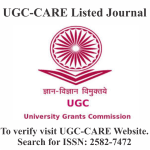DIGITAL DOMINANCE: EXPLORING THE REASONS BEHIND THE WANING POPULARITY OF PRINT MEDIA
DOI:
https://doi.org/10.29121/shodhkosh.v5.i5.2024.4542Abstract [English]
In a time when digital technology rules, the print media sector has changed dramatically. Print media, which was once seen as the main source of news and information, has had to change and reinvent itself to thrive in the digital era. This article examines the different ways that print media has changed, including the advent of online publications, the fall of traditional newspapers, and the creation of new hybrid models.
References
Arora, T., Agarwal, B., & Kumar, A. (2018). A study of millennials's preferences for social media advertising in Delhi NCR. Indian Journal of Marketing, 48(10), 34-51. DOI: https://doi.org/10.17010/ijom/2018/v48/i10/132334
Barthelemy, S., Bethell, M., Christiansen, T., Jarsvall, A., &Koinis, K. (2011). The future of print media. Retrieved Jan, 4, 2015.
Benson, R., Blach-Ørsten, M., Powers, M., Willig, I., & Zambrano, S. V. (2012). Media systems online and off: Comparing the form of news in the United States, Denmark, and France. Journal of Communication, 62(1), 21-38. DOI: https://doi.org/10.1111/j.1460-2466.2011.01625.x
Bhardwaj, A., & Kumar, V. (2022). Web and social media approach to marketing of engineering courses in India. International Journal of Business Innovation and Research, 27(4), 541-555. DOI: https://doi.org/10.1504/IJBIR.2022.122509
Briggs, R., & Hollis, N. (1997). Advertising on the web: Is there response before click-through?. Journal of Advertising research, 37(2), 33-46.
Bucher, H. J., & Schumacher, P. (2006). The relevance of attention for selecting news content. An eye-tracking study on attention patterns in the reception of print and online media. DOI: https://doi.org/10.1515/COMMUN.2006.022
Carter, Rob (1997). Color and Type. Watson Guptill Publications;New York.
Dash, M., &Belgaonkar, P. (2012). Comparative effectiveness of radio, print and web advertising. Print and Web Advertising (August 15, 2012). DOI: https://doi.org/10.2139/ssrn.2190083
Doudaki, V., &Spyridou, L. P. (2013). Print and online news: Remediation practices in content and form. Journalism Studies, 14(6), 907-925. DOI: https://doi.org/10.1080/1461670X.2012.746860
Kalombe, C., & Phiri, J. (2019). Impact of online media on print media in developing countries. Open Journal of Business and Management, 7(04), 1983. DOI: https://doi.org/10.4236/ojbm.2019.74136
Lefter, 2018. Ethics and advertising-Female targeted advertisement and the ethical concerns of practitioners and scholars.
Mathai, S., &Jeswani, S. (2021). Effectiveness of print media marketing in digital age: a study on Indian telecommunication industry. FIIB Business Review, 10(3), 242-254. DOI: https://doi.org/10.1177/2319714521992631
McMullan, J., 2020. A new understanding of ‘New Media’: Online platforms as digital mediums. Convergence, 26(2), pp.287-301. DOI: https://doi.org/10.1177/1354856517738159
Pareek, M., M., Dua, N., & Mittal, M.(2022). Academy of Marketing Studies Journal, 26(1), 1-19.
Rajendran, L. and Thesinghraja, P., 2014. The impact of new media on traditional media. Middle-East Journal of Scientific Research, 22(4), pp.609-616.
Shaouf, A. A. A. (2018). Revising the effects of online advertising attributes on consumer processing and response. International Journal of Marketing Studies, 10(1), 39-53. DOI: https://doi.org/10.5539/ijms.v10n1p39
Downloads
Published
How to Cite
Issue
Section
License
Copyright (c) 2024 Raimohan Dash, Dr. Ramkrishna Ghosh

This work is licensed under a Creative Commons Attribution 4.0 International License.
With the licence CC-BY, authors retain the copyright, allowing anyone to download, reuse, re-print, modify, distribute, and/or copy their contribution. The work must be properly attributed to its author.
It is not necessary to ask for further permission from the author or journal board.
This journal provides immediate open access to its content on the principle that making research freely available to the public supports a greater global exchange of knowledge.




















